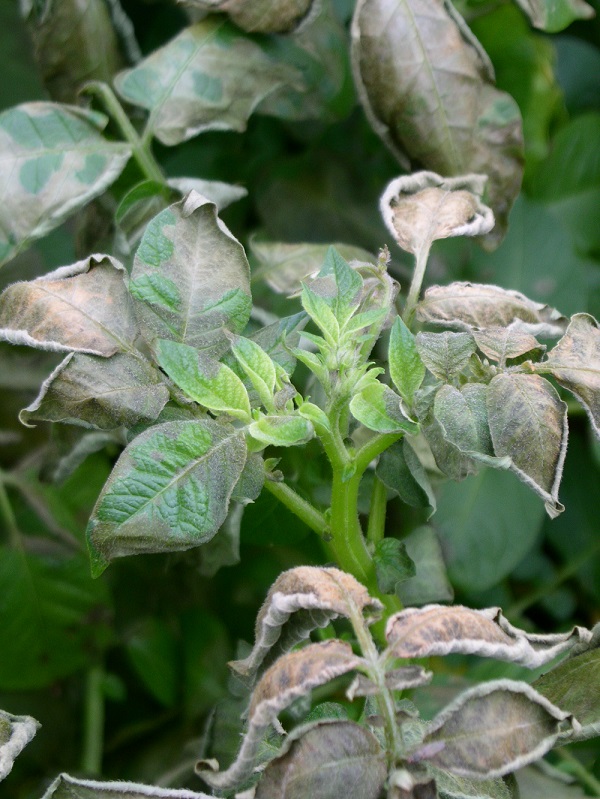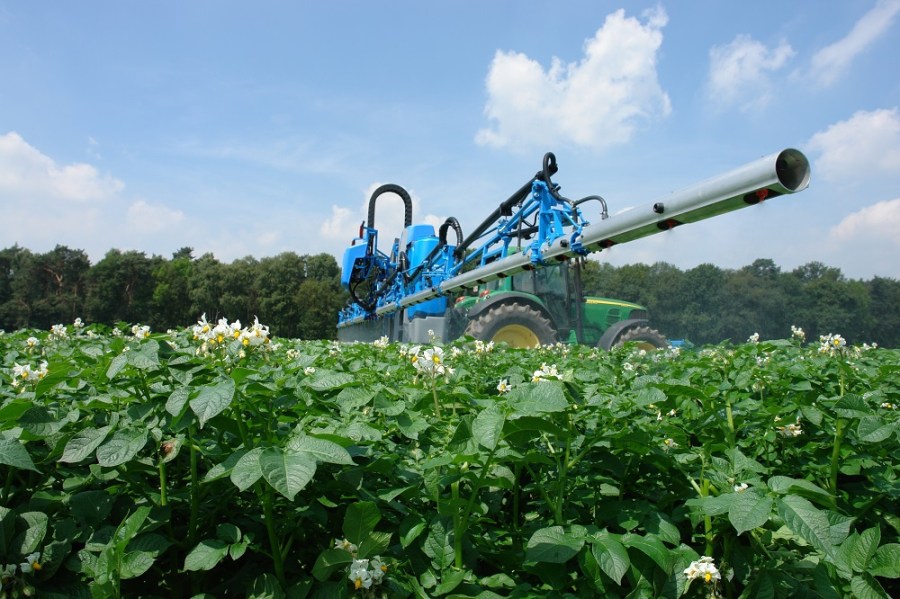The loss of plant protection products either through revocation or resistance will make blight control more difficult in 2019. CPM finds out how.
This is a real challenge for implementing integrated IPM strategy for late blight.
By Rob Jones
The loss of diquat as a desiccant herbicide combined with the need to avoid applications of a single mode of action (MOA) or consecutive applications of the same fungicide is set to make blight control more complicated, and potentially more expensive, according to Greg Dawson, agronomist for Scottish Agronomy.
With outgrade piles and other local sources now widely accepted as the main reservoirs for late blight (Phytophthora infestans) infection in field crops, the pressure is on growers to improve control of potato volunteers in previously cropped land and in dumps.

Planning has become an important element in blight strategies to comply with anti-resistance label requirements.
“The source of infection, be it seed or a local reservoir, has been heavily debated for many years, but genotyping performed on samples submitted for testing in 2017 and 2018 has helped to resolve the question. Planted seed, as well as local sources from waste piles are the main primary inoculum sources of the disease,” says Greg.
Unfortunately, the task of effectively controlling the spread of blight from local sources has been made more difficult with the revocation of diquat.
“Growers can either ensure dumps are covered with enough soil to prevent any potatoes emerging, or more likely, cover with black plastic to block sunlight and stop anything that emerges underneath from being able to grow. Some may not see either as a practical solution, but there are few alternatives. Glyphosate is simply too slow to act as plants will be able to sporulate for up to two weeks before leaf tissue is sufficiently dead to stop sporangia being produced,” he adds.
The need to achieve better early control of sources of infection is one of two developments that distinguish this season from previous years, with the other being the need to give greater thought to resistance management.
This has taken on greater significance since the spread of the fluazinam-resistant 37_A2 genotype (also referred to as ‘Dark Green 37’) in 2016 and a more recent finding that another new strain, 36_A2, is more aggressive than other genotypes found in the UK.
For that reason, Scottish Agronomy will be avoiding the sole use of carboxylic acid amide (CAA) products, such as Revus (mandipropamid), instead preferring to add a partner product, and they will avoid the practice of ‘blocking’, where the same product is used in consecutive applications, says Greg.
With 13 MOAs available for late blight control, ensuring crops are suitably protected might not seem too challenging. But that’s not the case, he says – only three actives are considered to have good activity against zoospores and therefore against tuber blight.
Fluazinam is one, but for those who don’t want to run the risk of insensitivity that leaves just two: Quinone inside Inhibitors (QiI) which belong to FRAC code 21 and the pyridinylmethyl-benzamide group containing fluopicolide, belonging to FRAC code 43.
“Both Shinkon/Gachinko (amisulbrom) and Ranman Top (cyazofamid) are QiI fungicides, meaning that to comply with an effective resistance management strategy, they shouldn’t be used consecutively or in mixtures with each other,” explains Greg.
Furthermore, FRAG-UK resistance management guidelines for the QiI group are that they shouldn’t form more than 50% of the intended programme and that CAA group fungicides shouldn’t exceed six applications when used in a mixture, or four when used alone, and for no more than 33% of the blight programme.
“This is reasonably straightforward to overcome so long as growers make use of products other than QiIs in the rapid canopy phase and alternate use of the remaining QiI applications with Infinito (fluopicolide+ propamocarb), which can be applied up to four times per crop.
“For example, if Zorvec Enicade (oxathiapiprolin) is mixed with amisulbrom during rapid canopy growth, this limits the number of QiI applications later in the programme when the focus turns to tuber blight protection,” he explains.
“Zorvec is best utilised at the rapid canopy phase, so the big question is how many times to apply it with a QiI, if some QiI applications are to be saved for later in the programme,” he adds.
The use of these two Qil products and Infinito need to be planned carefully to ensure that enough fungicides with tuber blight activity are retained for when they’re needed. This is particularly important, he stresses, for those who choose to deploy Infinito for its foliar activity and systemic mobility during the rapid canopy growth phase.
Tubers are at risk of infection from the point of initiation. With the exception of very old seed, the interval from plant emergence to the onset of tuber initiation is usually 2-3 weeks in many cultivars and slightly longer in others such as Cara.
“A grower wanting to incorporate robust tuber protection from then on will need to alternate between QiIs and Infinito. Hence the need to plan applications during rapid canopy,” he explains.
To complicate matters, limited testing of 36_A2, another strain which has spread rapidly across Europe to become common across Germany, Belgium, the Netherlands, France, Poland, Denmark and arrived in the UK in 2017, has demonstrated a fitness advantage over other strains.
While the spread of 37_A2 has effectively ended the use of fluazinam as a tuber blight protectant, it still has a role to play in powdery scab control at planting time in seed crops and sclerotinia control in ware crops.
“In varieties where sclerotinia is a concern, for example Maris Piper, then fluazinam could be added to the second blight spray in a mix with Revus. But in crops where sclerotinia isn’t an issue but alternaria is, such as in Markies, Vivaldi or King Edward, then Revus plus mancozeb would be the better option because it would give a baseline protection against alternaria, as well as a resistance mechanism for protecting CAA modes of action,” explains Greg.
Earlier this year, AHDB published research performed by the James Hutton Institute which found 36_A2 formed larger lesions at low dose rates of several fungicide MOAs when compared with other strains.
This finding prompted Scottish Agronomy to advise the use of a suitable mixing partner to promote crop protection during the rapid canopy phase. As potato plants are growing quickly at this time, a product such as Revus, which is bound to the leaf wax of newly developing leaf primordia, will be quickly diluted to low concentrations within the canopy and may struggle to control blight, suggests Greg.
“It’s not sensible, given what we know about the aggressiveness of 36_A2, to apply Revus (mandipropamid) without a mixing partner such as mancozeb during the rapid canopy phase.
“The arrival of yet another more aggressive strain challenges two points – the suggestion that variety resistance has a greater role to play in structuring programmes and the intention of those planning to extend intervals to more than seven days. It’s high risk in both instances,” he adds.
What is notable is that virulence comparisons, within and between late blight clones, indicate 37_A2, 36_A2, 13_A2 (better known as ‘Blue 13’) and 41_A2 all are able to overcome a high number of resistance genes.
“This is a real challenge for implementing an integrated IPM strategy for late blight,” he emphasises. “There’s a recurrent emergence of invasive clones. 36_A2 and 37_A2 are displacing 13_A2 and 6_A1 (typically referred to as ‘Pink 6’) in the UK. Concerningly, a new clone called 41_A2 is expanding in the late blight population in Scandinavia, which is more diverse than in the UK,” he says.
All the clones active in the UK are acknowledged as aggressive clones, as genotype information is as yet unable to predict the risk that a clone presents to crops in a particular region. This means that from a control perspective, all clones are equally threatening.
Advisers often talk about new strains of blight as having a ‘fitness advantage’ that marks them out as being ‘more aggressive’ than those that preceded them, but what does it mean, and does it apply equally to foliar blight and tuber blight?
“The term ‘fitness advantage’ is often used to cover several characteristics that separate new genotypes from those that preceded them. It can be used to describe its biotrophic nature, where it can sporulate while keeping the leaf alive for longer, the length of life cycle or the ability to overcome resistance genes.
“To be successful it has to be aggressive-enough to establish itself in the canopy, but not so aggressive that it kills the tuber before it emerges the following year, otherwise it would rid itself of the ability to spread across seasons. There are small differences in the way the symptoms manifest, but they’re not so large as to support a change in crop management strategies as when it comes to tuber blight; they’re all equally aggressive,” explains Greg.
Practical considerations for blight control
For Norfolk grower Mark Means, who grows 100-120ha of pre-pack potatoes for the multiple retailers and sometimes storing for up to 48 weeks, tuber blight protection has taken on equal importance to canopy protection. This season his first blight spray of 2019 was applied on 12 May.
“About 70% of the crop is on unirrigated silts which affords some flexibility in the blight strategy. But, with a range of determinant and indeterminant varieties to manage and having spent heavily at planting to ensure we start with a good seedbed, it’s short-sighted to cut corners with crop protection,” says Mark, who farms at Terrington St Clements.
At the start of the season when all varieties are growing rapidly, he seeks to keep applications simple, though irrigated crops will often receive higher application rates or more robust product mixes.
“We still follow a seven-day programme on the unirrigated crops, but fungicide choice would be based around cymoxanil and mancozeb,” he says.
Once crops reach full canopy there’s the opportunity to extend spray intervals, principally on the unirrigated crops, but doing so comes with increased risks. “If the weather changes or if there’s a dump upwind that begins to sporulate, you can soon find yourself in trouble.”
Aiming to maintain seven-day intervals, the farm has ensured it can travel in sometime unfavourable conditions by moving to wider tyres and adding additional tramlines within the crop.
The focus is one of prevention rather than cure. “I will often seek to make strategic use of the better products based on the assessed risk which is derived from weather data, the number of Hutton Criteria warnings and discussions with our agronomist.
“Last year we made one application of Zorvec to an irrigated crop during rapid canopy because of its protectant and systemic activity, but while keeping the canopy clean is important, tuber blight is of equal concern. If pressure is high and we need additional products with systemic activity, we can always utilise Infinito,” says Mark.
“Blight is becoming more aggressive in its nature and increasingly capable of sporulating at lower temperatures, so we need to be vigilant. This is perhaps best evidenced by the loss of fluazinam, which is something we have felt acutely,” he adds.
With a large area of unirrigated crops, great efforts are made to retain soil moisture at depth. “Protecting soils is almost a contradiction in terms when you’re a potato grower, but we seek to minimise the amount of deep cultivations needed. This means taking a 3-4 year horizon when planning field operations to make sure the soil structure is in good order ahead of potatoes,” he says.
While the late blight pathogen populations are evolving fast, the arsenal of control methods useful for controlling them is expanding through improved decision support mechanisms, in field sensors and novel breeding methods, among other methods.
“Faced with increasingly stringent regulations on pesticide approval, developing open-science IPM strategies is central to efforts to achieve sustainable control of late blight. The concept of IPM has been accepted and incorporated into regulation, but the holistic nature of IPM has not yet been embraced by growers,” observes Greg.
“There’s a clear need to formulate general principles for synergistically combining traditional and novel IPM actions to improve efforts to optimise late blight control solutions. It’s not sustainable to be dependent solely on either genetics or chemistry.
“Integrated blight control requires a suite of effective fungicides, each performing as expected. It’s worth noting that of the 49 new active substances submitted for approval since June 2011, six active substances were approved, but of these only two have activity on late blight. As an industry we must improve stewardship of existing products to retain efficacy and choice,” he says.




